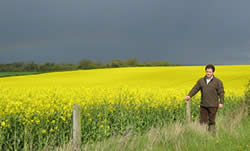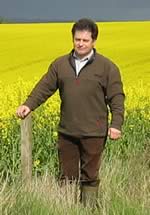| Printer Friendy Version |
Published in the Farm Contractor Magazine and the Crop Production Magazine, June 2005.
HAMPSHIRE FARM CUTS ESTABLISHMENT COSTS WITH NEW TECHNIQUE FOR OIL SEED RAPE
Switching to Till-Seeding has significantly reduced the cost of oil seed rape establishment on a Hampshire arable enterprise by offering a faster, simpler system that requires less labour. 
Hazeley Estate at Twyford, Winchester, extends to 1600 acres, 1300 acres of which is arable, mainly cereals and oil seed rape. Spring barley is the predominant crop with nearly 500 acres, plus some 300 acres of wheat and 350 acres of rape. The soil is on the light side, with flints over chalk.
Hazeley Estate has been growing rape for some 17 years – mainly Winner & Canberra with a piece of Royal hybrid. “Hybrids have been grown here for a while but I think we shall probably go away from the Royal next year and, depending on how much more ground we take on, concentrate on Winner, Canberra and possibly a bit of Castille,” says estate manager Charles Macleod.
Until two years ago, seedbed preparation was based on a conventional plough based system: plough, spring tine, and drill with a conventional Accord seeder and roll.
The introduction of the Till-Seeding system, based on an OPICO fully electronic Variocast 8 Seeder fitted to a 6.5 metre Rexus Carrier System disc, had the primary objective of reducing the cost of establishment. With the second crop now well under way, Mr Macleod is convinced the decision was the right one.
“Basically we are doing one pass with the System disc, allowing things to green up, and then spraying off,” he says. “Usually we try and wait for a little bit of moisture. But if that’s not possible we’ll go again, then bring in the Variocast to seed and cultivate at the same time.
“Depending on how long it takes to green up, if you get in right behind the combine and get an instant chit, you’ve got between 10 and 14 days between the first pass and drilling pass.”
The switch to the Variocast was largely to do with speed, explained Mr Macleod. “Coupled with the fact that, when I came here two and a half years ago, there were four members of staff, whereas now there are only two – myself and one other. But it works very well.
“Obviously it cuts out cost. It is faster because we pull the 6.5 metre Rexius with a 280 hp tractor and can drill at up to 14kph. You can actually drill close on 300-400 acres per day if you want to.
“However with all this comes more risk. It is a system that relies on moisture. You need to have some moisture either very resident in the top layer of the soil when you drill and roll it in, or you need to have some rainfall afterwards.
“We also experienced the problems other people have with chopped straw. If I can get rid of the straw, it is a system that works well in that the machine working in stubble with just chaff on in it will actually get the seed mixed in amongst the soil.
“But if you’ve got a mat of chopped straw in the fourteen day break between the first and second passes, the straw doesn’t have time to start breaking down sufficiently. So you do take a bit of a risk spreading the seed about where potentially it may lie in amongst some chopped straw.
“Like all these systems if you cut some cost out and accelerate the speed, you do have to pay for it somewhere. The payment is the fact that you are taking a bigger risk: you have to be more careful about when you actually decide to go drilling because you can’t physically drill into moisture. You are actually broadcasting it on the surface in front of the rollers.”
Slug problems had been more significant, added Mr Macleod. “We can’t use a Till-Seeder system for putting Royal in because the seed rates are less than half the rate that a conventional variety would be drilled at. You can’t take the risk in having less than a very good percentage emergence - so consequently that is put in with the drill.”
However, in very dry conditions, even with the plough, press and drill operation, he didn’t get a significantly better stand of the Royal than he did with the Winner which was broadcast from the OPICO Variocast and the Carrier.
get a significantly better stand of the Royal than he did with the Winner which was broadcast from the OPICO Variocast and the Carrier.
“Overall, speed wise the system is very good,” says Mr Macleod, “especially for people looking for very close wheat/rape rotations where a lot more speed is required after the wheat harvest to get the rape in at a suitable time.
“Certainly the Variocast is a simple, low cost tool and it has improved the usage of the Rexus. I have to say it has been a very good piece of kit – easy to calibrate, easy to use, and reliable.
“In future, the only thing we might do is slightly alter the way that the seed is discharged, just to get it closer to the disturbed soil. But apart from that no, it works well and we have done quite a lot of grass seed with it as well.”







